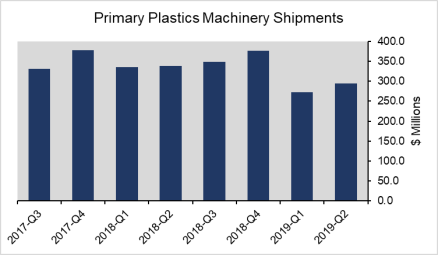Plastics machinery shipments improved in the second quarter
The shipments value of primary plastics machinery (injection moulding and extrusion) shipments in North America increased in the second quarter according to the statistics compiled and reported by the Plastics Industry Association’s (Plastics) Committee on Equipment Statistics (CES).
Following a 27.6% decrease in the first quarter, plastics machinery shipments increased 8.2% in the second quarter. However, shipments remained sluggish from the second quarter of the previous year—12.7% lower.
The preliminary estimate of shipment value from reporting companies totaled $295.3 million. Injection moulding shipments rose 7.4% and single- and twin-extrusion equipment shipments increased 13.6% and 13.9%, respectively. While the value of shipments for single-screw extruders and injection moulding equipment increased 4.3% and 7.4%, respectively, for a year ago, twin-screw extruders were 29.5% lower.
“The second quarter numbers are encouraging, but machinery shipments remain comparatively lower than the previous quarters. What’s happening is not surprising judging from the macroeconomic environment. Real business investment spending in the second quarter fell 5.5%. In particular, the investment spending in industrial equipment flattened in the second quarter,” according to Perc Pineda, PhD, chief economist of Plastics.
The CES also conducts a quarterly survey of plastics machinery suppliers that asks about present market conditions and expectations for the future. In the coming quarter, 56% of respondents expect conditions to either improve or hold steady—lower than the 70% that felt similarly in the previous quarter. As for the next 12 months, 53% expect market conditions to be steady-to-better, down from 60% in the previous quarter’s survey.
On the international trade front, plastics machinery exports in the second quarter totaled $378.8 million—a 4.3% increase from the previous quarter. Mexico, Canada and Germany remained the largest U.S. export markets. More than half (53%) of U.S. plastics machinery was exported to these three countries. While exports to China increased 11.4% in the second quarter, it was 37% lower than during the same period the previous year. “In the short-term there are two outstanding issues that need to be resolved. Mexico has ratified the U.S.-Mexico-Canada Agreement (USMCA), but the U.S. and Canada have yet to sign off on this critical North American trade pact. Both countries must ratify the USMCA. Unless that is resolved, the uncertainty from the ongoing U.S.-China trade dispute will continue to run high and will negatively impact not only the plastics industry but the global economy,” Pineda added.

